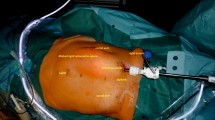Abstract
Background
After years of playing second-fiddle to laparoscopic underlay repairs, the retro-muscular Rives-Stoppa repair is rapidly gaining popularity thanks to the endoscopic eTEP approach. It extends all the advantages of a retro-muscular mesh placement—increased tolerance for infection, mechanical robustness, reduced need for mesh fixation—in an ergonomically acceptable system.
Methods
The eTEP technique described by Belyansky’s group requires a “crossover” from one retro-rectus space to the other. The aim of the crossover is to safely amalgamate the retro-rectus spaces for placement of a large extra-peritoneal prosthesis. By salvaging peritoneum in the midline and operating in the extra-peritoneal plane, one can avoid large defects in the posterior rectus sheath (PRS)-peritoneum complex which need closure. Correct identification of anatomical landmarks is imperative to safely perform the surgery.
Results
The “lamppost sign” signals the lateral limit of retro-rectus dissection, preventing iatrogenic injury to the neurovascular bundles and linea semilunaris. After crossover has been safely achieved, the medial edges of the divided posterior rectus sheaths are found connected to each other by a strip of pre-peritoneal fat and peritoneum in the midline. These structures, along with the neck of hernia constitute the “volcano sign”. For inferior defects, the vas deferens, the inferior epigastric and gonadal vessels form a triradiate conformation termed the “Mercedes-Benz sign”.
Conclusion
These signs serve as tools to identify the composition of the surgical field, avoiding iatrogenic injury to the linea alba and linea semilunaris, while reducing the time taken for posterior closure.









Similar content being viewed by others
References
Fink C, Baumann P, Wente MN, Knebel P, Bruckner T, Ulrich A, Werner J, Büchler MW, Diener MK (2014) Incisional hernia rate 3 years after midline laparotomy. Br J Surg 101:51–54. https://doi.org/10.1002/bjs.9364
Mudge M, Hughes LE (1985) Incisional hernia: a 10 year prospective study of incidence and attitudes. Br J Surg 72:70–71
Le Huu NR, Mege D, Ouaïssi M, Sielezneff I, Sastre B (2012) Incidence and prevention of ventral incisional hernia. J Visc Surg 149:e3–e14. https://doi.org/10.1016/j.jviscsurg.2012.05.004
Holihan JL, Nguyen DH, Nguyen MT, Mo J, Kao LS, Liang MK (2016) Mesh location in open ventral hernia repair: a systematic review and network meta-analysis. World J Surg 40:89–99
Rives J, Pire JC, Flament JB, Convers G (1977) Treatment of large eventrations (apropos of 133 cases). Minerva Chir 32:749–756
Stoppa RE (1989) The treatment of complicated groin and incisional hernias. World J Surg 13:545–554. https://doi.org/10.1007/BF01658869
Miserez M, Penninckx F (2002) Endoscopic totally preperitoneal ventral hernia repair: surgical technique and short-term results. Surg Endosc Other Interv Tech 16:1207–1213. https://doi.org/10.1007/s00464-001-9198-z
Belyansky I, Daes J, Radu VG, Balasubramanian R, Reza Zahiri H, Weltz AS, Sibia US, Park A, Novitsky Y (2018) A novel approach using the enhanced-view totally extraperitoneal (eTEP) technique for laparoscopic retromuscular hernia repair. Surg Endosc Other Interv Tech 32:1525–1532. https://doi.org/10.1007/s00464-017-5840-2
Daes J (2012) The enhanced view-totally extraperitoneal technique for repair of inguinal hernia. Surg Endosc Other Interv Tech 26:1187–1189. https://doi.org/10.1007/s00464-011-1993-6
Conze J, Prescher A, Klinge U, Saklak M, Schumpelick V (2004) Pitfalls in retromuscular mesh repair for incisional hernia: the importance of the “fatty triangle”. Hernia 8:255–259. https://doi.org/10.1007/s10029-004-0235-4
Moore AM, Anderson LN, Chen DC (2016) Laparoscopic stapled sublay repair with self-gripping mesh: a simplified technique for minimally invasive extraperitoneal ventral hernia repair. Surg Technol Int 29:131–139
Muysoms FE, Miserez M, Berrevoet F, Campanelli G, Champault GG, Chelala E, Dietz UA, Eker HH, El Nakadi I, Hauters P, Hidalgo Pascual M, Hoeferlin A, Klinge U, Montgomery A, Simmermacher RKJ, Simons MP, Śmietański M, Sommeling C, Tollens T, Vierendeels T, Kingsnorth A (2009) Classification of primary and incisional abdominal wall hernias. Hernia 13:407–414. https://doi.org/10.1007/s10029-009-0518-x
Acknowledgements
The authors would like to thank Dr. Rockson Liu for contributing an operative image (Fig. 8) for the manuscript.
Funding
No financial support was received for this study.
Author information
Authors and Affiliations
Contributions
All authors certify that they accept responsibility as an author and have contributed to the concept, literature review, manuscript drafting, and give their final approval.
Corresponding author
Ethics declarations
Conflict of interest
Dr. Ramana Balasubramaniam has no conflict of interest or financial ties to disclose. Dr. Eham Arora has received honoraria for speaking engagements from Johnson & Johnson Pvt Ltd, India. Dr. Belyansky has received honoraria for speaking engagements and consulting work from Intuitive, Bard Davol and Medtronic; he is an investor in IHC Inc.
Ethical approval
The description of anatomical landmarks necessitated no deviation from prevailing accepted surgical technique, hence it did not require institutional review board approval.
Human and animal rights
All procedures performed in studies involving human participants were in accordance with the ethical standards of the institutional and/or national research committee and with the 1964 Helsinki Declaration and its later amendments or comparable ethical standards. This article does not contain any studies with animals performed by any of the authors.
Informed consent
Informed consent was obtained from all individual participants included in the study.
Additional information
Publisher's Note
Springer Nature remains neutral with regard to jurisdictional claims in published maps and institutional affiliations.
Rights and permissions
About this article
Cite this article
Ramana, B., Arora, E. & Belyansky, I. Signs and landmarks in eTEP Rives-Stoppa repair of ventral hernias. Hernia 25, 545–550 (2021). https://doi.org/10.1007/s10029-020-02216-4
Received:
Accepted:
Published:
Issue Date:
DOI: https://doi.org/10.1007/s10029-020-02216-4




